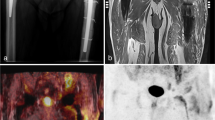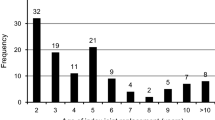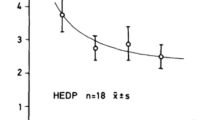Abstract
Purpose
The purpose of this study was to evaluate 18F-fluorodeoxyglucose (FDG) uptake in patients with painful total knee arthroplasty and to relate FDG uptake to the location of soft tissue pain.
Methods
Twenty-eight patients with painful total knee arthroplasty had a clinical examination, standard radiographs, CT measurement of rotation of the femoral component and FDG-PET (18 PET/CT, 10 PET). The diagnosis of infection was based on microbiological examinations of surgical specimens (n=12) or clinical follow-up for at least 6 months (n=16), 99mTc-labelled monoclonal antibody scintigraphy and joint aspiration.
Results
Twenty-seven of 28 patients presented with diffuse synovial FDG uptake. Additional focal extrasynovial FDG uptake was observed in 19 knees. Twenty-four of the 28 patients had a diagnosis of internal femoral malrotation. The remaining four patients showed no rotation (0°) and 3°, 4° and 7° of external rotation, respectively. Three patients presented with the additional diagnosis of an infected total knee replacement. Pain was described as diffuse (n=10) or focal (n=18). In two knees a relationship between pain location and FDG uptake was observed. Of ten patients with a severe internal femoral component rotation (>6°), seven had focal uptake, four in the femoral periosteum and three in the tibial periosteum. The difference between knees with severe malrotation and the remaining knees was not significant (p=1.000, Fisher's Exact Test).
Conclusion
Diffuse synovial and focal extrasynovial FDG-PET uptake is commonly found in patients with malrotation of the femoral component and is not related to pain location. The information provided by FDG-PET does not contribute to the diagnosis and management of individual patients with persistent pain after total knee replacement.




Similar content being viewed by others
References
Berger RA, Crossett LS, Jacobs JJ, Rubash HE. Malrotation causing patellofemoral complications after total knee arthroplasty. Clin Orthop Relat Res 1998;356:144–153
Berger RA, Rubash HE. Rotational instability and malrotation after total knee arthroplasty. Orthop Clin North Am 2001;32:639–647, ix
Hofmann S, Romero J, Roth-Schiffl E, Albrecht T. Rotational malalignment of the components may cause chronic pain or early failure in total knee arthroplasty. Orthopade 2003;32:469–476
Clarke HD, Scuderi GR. Flexion instability in primary total knee replacement. J Knee Surg 2003;16:123–128
Argenson JN, Aubaniac JM. Total knee arthroplasty in femorotibial instability. Orthopade 2000;29 Suppl 1:S45–47
Nabeyama R, Matsuda S, Miura H, Kawano T, Nagamine R, Mawatari T, et al. Changes in anteroposterior stability following total knee arthroplasty. J Orthop Sci 2003;8:526–531
Malo M, Vince KG. The unstable patella after total knee arthroplasty: etiology, prevention, and management. J Am Acad Orthop Surg 2003;11:364–371
Parker DA, Dunbar MJ, Rorabeck CH. Extensor mechanism failure associated with total knee arthroplasty: prevention and management. J Am Acad Orthop Surg 2003;11:238–247
Sharkey PF, Hozack WJ, Rothman RH, Shastri S, Jacoby SM. Insall Award paper. Why are total knee arthroplasties failing today? Clin Orthop Relat Res 2002;404:7–13
Boldt JG, Munzinger UK, Zanetti M, Hodler J. Arthrofibrosis associated with total knee arthroplasty: gray-scale and power Doppler sonographic findings. AJR Am J Roentgenol 2004;182:337–340
Hendrix RW. Radiographic evaluation of prosthetic joints. Compr Ther 1988;14:36–48
Ducheyne P, Kagan A, 2nd, Lacey JA. Failure of total knee arthroplasty due to loosening and deformation of the tibial component. J Bone Joint Surg Am 1978;60:384–391
Hirsh DM, Bhalla S, Roffman M. Supracondylar fracture of the femur following total knee replacement. Report of four cases. J Bone Joint Surg Am 1981;63:162–163
Bauer TW, Schils J. The pathology of total joint arthroplasty.II. Mechanisms of implant failure. Skeletal Radiol 1999;28:483–497
Van Acker F, Nuyts J, Maes A, Vanquickenborne B, Stuyck J, Bellemans J, et al. FDG-PET, 99mTc-HMPAO white blood cell SPET and bone scintigraphy in the evaluation of painful total knee arthroplasties. Eur J Nucl Med 2001;28:1496–1504
Briard JL, Hungerford DS. Patellofemoral instability in total knee arthroplasty. J Arthroplast 1989;4 Suppl:S87–97
Merkow RL, Soudry M, Insall JN. Patellar dislocation following total knee replacement. J Bone Joint Surg Am 1985;67:1321–1327
Romero J, Duronio JF, Sohrabi A, Alexander N, MacWilliams BA, Jones LC, et al. Varus and valgus flexion laxity of total knee alignment methods in loaded cadaveric knees. Clin Orthop Relat Res 2002;394:243–253
Sciuk J, Puskas C, Greitemann B, Schober O. White blood cell scintigraphy with monoclonal antibodies in the study of the infected endoprosthesis. Eur J Nucl Med 1992;19:497–502
Freeman MA, Sudlow RA, Casewell MW, Radcliff SS. The management of infected total knee replacements. J Bone Joint Surg Br 1985;67:764–768
Goksan SB, Freeman MA. One-stage reimplantation for infected total knee arthroplasty. J Bone Joint Surg Br 1992;74:78–82
Simmons TD, Stern SH. Diagnosis and management of the infected total knee arthroplasty. Am J Knee Surg 1996;9:99–106
Schiesser M, Stumpe KD, Trentz O, Kossmann T, Von Schulthess GK. Detection of metallic implant-associated infections with FDG PET in patients with trauma: correlation with microbiologic results. Radiology 2003;226:391–398
de Winter F, van de Wiele C, Vogelaers D, de Smet K, Verdonk R, Dierckx RA. Fluorine-18 fluorodeoxyglucose-position emission tomography: a highly accurate imaging modality for the diagnosis of chronic musculoskeletal infections. J Bone Joint Surg Am 2001;83-A:651–660
Stumpe KD, Notzli HP, Zanetti M, Kamel EM, Hany TF, Gorres GW, et al. FDG PET for differentiation of infection and aseptic loosening in total hip replacements: comparison with conventional radiography and three-phase bone scintigraphy. Radiology 2004;231:333–341
Love C, Tomas MB, Marwin SE, Pugliese PV, Palestro CJ. Role of nuclear medicine in diagnosis of the infected joint replacement. Radiographics 2001;21:1229–1238
Love C, Marwin SE, Tomas MB, Krauss ES, Tronco GG, Bhargava KK, et al. Diagnosing infection in the failed joint replacement: a comparison of coincidence detection 18F-FDG and 111In-labeled leucocyte/99mTc-sulfur colloid marrow imaging. J Nucl Med 2004;45:1864–1871
von Schulthess GK, Meier N, Stumpe KD. Joint accumulations of FDG in whole body PET scans. Nuklearmedizin 2001;40:193–197
Oi N, Iwaya T, Itoh M, Yamaguchi K, Tobimatsu Y, Fujimoto T. FDGPET imaging of lower extremity muscular activity during level walking. J Orthop Sci 2003;8:55–61
Meyer M, Gast T, Raja S, Hubner K. Increased F-18 FDG accumulation in an acute fracture. Clin Nucl Med 1994;19:13–14
Zhuang H, Sam JW, Chacko TK, Duarte PS, Hickeson M, Feng Q, et al. Rapid normalization of osseous FDG uptake following traumatic or surgical fractures. Eur J Nucl Med Mol Imaging 2003;30:1096–1103
Kaim AH, Gross T, von Schulthess GK. Imaging of chronic posttraumatic osteomyelitis. Eur Radiol 2002;12:1193–1202
Akagi M, Yamashita E, Nakagawa T, Asano T, Nakamura T. Relationship between frontal knee alignment and reference axes in the distal femur. Clin Orthop Relat Res 2001;388:147–156
Schmidlin P. Improved iterative image reconstruction using variable projection binning and abbreviated convolution. Eur J Nucl Med 1994;21:930–936
Zhuang H, Duarte PS, Pourdehnad M, Maes A, Van Acker F, Shnier D, et al. The promising role of 18F-FDG PET in detecting infected lower limb prosthesis implants. J Nucl Med 2001;42:44–48
Ryd L, Gustafson T, Lindstrand A. 99mTc-diphosphonate scintigraphy in successful knee arthroplasty and its relation to micromotion. Clin Orthop Relat Res 1993;287:61–67
Rosenthall L, Lepanto L, Raymond F. Radiophosphate uptake in asymptomatic knee arthroplasty. J Nucl Med 1987;28:1546–1549
Becker W, Pasurka B, Borner W. Significance of leukocyte scintigraphy of the infected total endoprosthesis. Rofo 1989;150:284–289
Palestro CJ, Kim CK, Swyer AJ, Capozzi JD, Solomon RW, Goldsmith SJ. Total-hip arthroplasty: periprosthetic indium-111-labeled leukocyte activity and complementary technetium-99m-sulfur colloid imaging in suspected infection. J Nucl Med 1990;31:1950–1955
Manthey N, Reinhard P, Moog F, Knesewitsch P, Hahn K, Tatsch K. The use of [18F]fluorodeoxyglucose positron emission tomography to differentiate between synovitis, loosening and infection of hip and knee prostheses. Nucl Med Commun 2002;23:645–653
Author information
Authors and Affiliations
Corresponding author
Rights and permissions
About this article
Cite this article
Stumpe, K.D.M., Romero, J., Ziegler, O. et al. The value of FDG-PET in patients with painful total knee arthroplasty. Eur J Nucl Med Mol Imaging 33, 1218–1225 (2006). https://doi.org/10.1007/s00259-006-0127-1
Received:
Accepted:
Published:
Issue Date:
DOI: https://doi.org/10.1007/s00259-006-0127-1




